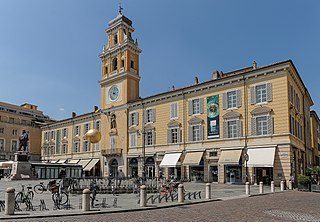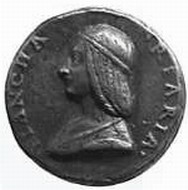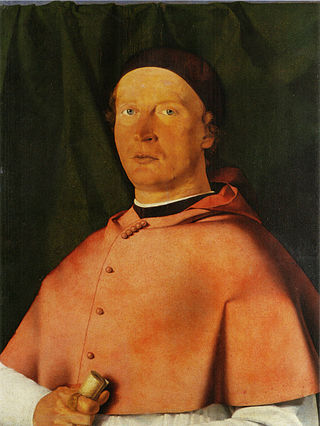Related Research Articles

Parma is a city in the northern Italian region of Emilia-Romagna known for its architecture, music, art, prosciutto (ham), cheese and surrounding countryside. With a population of 198,292 inhabitants, Parma is the second most populous city in Emilia-Romagna after Bologna, the region's capital. The city is home to the University of Parma, one of the oldest universities in the world. Parma is divided into two parts by the stream of the same name. The district on the west side of the river is Oltretorrente. Parma's Etruscan name was adapted by Romans to describe the round shield called Parma.

Caterina Sforza was an Italian noblewoman, the Countess of Forlì and Lady of Imola, firstly with her husband Girolamo Riario, and after his death as a regent of her son Ottaviano.
The War of Ferrara was fought in 1482–1484 between Ercole I d'Este, Duke of Ferrara, and the forces mustered by Ercole's personal nemesis, Pope Sixtus IV and his Venetian allies. Hostilities ended with the Treaty of Bagnolo, signed on 7 August 1484.

Girolamo Riario was Lord of Imola and Forlì. He served as Captain General of the Church under his uncle Pope Sixtus IV. He was one of the organisers of the failed 1478 Pazzi conspiracy against the Medici family, the rulers of Florence, and was assassinated 10 years later by members of the Forlivese Orsi family.

Bianca Riario was an Italian noblewoman and regent, Marchioness of San Secondo by marriage to Troilo I de' Rossi, and regent of the marquisate and county of San Secondo for her son Pier Maria during his minority between 1521 and 1522. She was the eldest child and only daughter of Caterina Sforza by the latter's first husband, Girolamo Riario, a nephew of Pope Sixtus IV.

The Torre del Gallo is a historical building located in Florence, Italy, located at Pian de' Giullari, in the hills of Arcetri, on top of a ridge overlooking the city where there is a magnificent panorama.

Bernardo de' Rossi was an Italian bishop and patron of the arts.

Pier Maria III de' Rossi was an Italian general and nobleman, the second marquess and seventh count of San Secondo.

Portrait of Camilla Gonzaga and Her Three Sons is a painting attributed to the Italian Mannerist artist Parmigianino and his workshop, executed around 1535–1537 and housed in the Museo del Prado, Madrid, Spain. It forms a pair with another painting in the Prado, the Portrait of Pier Maria Rossi di San Secondo, Camilla's husband, a painting which is unanimously assigned to Parmigianino.

The Sanvitale conspiracy was a plot to assassinate Ranuccio I Farnese, Duke of Parma and Piacenza, and members of his family at the baptism of his new-born son Alessandro in 1611. The conspiracy may also be referred to in Italian as the congiura dei feudatari, "conspiracy of the feudal lords", or as the congiura del 1611, "conspiracy of 1611".

The Monument to Giovanni delle Bande Nere is an Italian Renaissance sculpture in marble, by Baccio Bandinelli and his workshop, now in Piazza San Lorenzo in Florence, Tuscany, Italy. The work took from 1540 to after 1560 to carve, and the base and statue, though always meant to be together, were only so placed in 1850.

Pier Maria Rossi or Pier Maria II de' Rossi was an Italian condottiere and count of a region around present San Secondo Parmense. His properties included the castle of Rocca dei Rossi. He was known as "the Magnificent".
Angela Paola de' Rossi was an Italian noblewoman. She was born to Troilo I de' Rossi and Bianca Riario in San Secondo Parmense. Her first husband was Vitello Vitelli; they married in 1522. After Vitello's death in 1528, she married Alessandro Vitelli. Both husbands were from the Vitelli family. She died in Città di Castello.
Giovanni de' Rossi was an Italian condottiero and the fifth count of San Secondo. He was nicknamed 'il diseredato'.
Guido de' Rossi was an Italian condottiero.

The Rossi family is an Italian noble lineage originating from the Emilia region, now part of the province of Parma. Their history is well-documented in the archives of Parma and San Secondo. The earliest recorded mention of the Rossi family in Emilia dates back to 1323.
References
- 1 2 "Portale dedicato alla Storia di Parma e a Parma nella Storia, a cura dell'Istituzione delle Biblioteche di Parma ::: Dizionario biografico: Rondani-Ruzzi" (in Italian). www.parmaelasuastoria.it. Archived from the original on 2015-11-20.
- ↑ Although not listed in the 1464 will of Pier Maria II, in all other surviving documents in the Rossi archive Troilo I is given as Giovanni's son and in other fragments as the son of Angela Scotti Douglas. However, some doubts remain, since Troilo's cousin Bernardo de' Rossi (bishop of Treviso) states that "the Rossi bastard was in the French camp", referring to Troilo I and his father Giovanni being the only members of the Rossi family not to fight alongside the Venetians at Fornovo. It is unknown whether ""bastard" accurately describes Troilo I as illegitimate or whether its usage is simply pejorative - Bernardo considered Troilo I as usurping the fiefdom of San Secondo from its legitimate heir, Bernardo's brother Filippo Maria. See (in Italian)Le signorie dei Rossi di Parma, a cura di L. Arcangeli e M. Gentile, Firenze 2008 p. 267
- ↑ (in Italian) Letizia Arcangeli, Marco Gentile, Le signorie dei Rossi di Parma tra XIV e XVI secolo, Firenze University Press, 2007, p. 275 nota 215, ISBN 978-88-8453- 683-9.
- ↑ (in Italian) Cesare Marchi, Giovanni dalle Bande Nere, Milano, 1981.